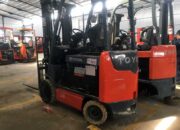One of the devices used to transport and unload goods are forklifts. Forklifts have become an essential part of every port, yard, warehouse or manufacturing facility. It is seen as versatile machines that can perform various tasks, both indoors and outdoors. The biggest benefit is that the forklifts have the power to complete a job that would normally require several people. So, having a forklift in your company will definitely save you a lot of money and effort.

– Electric forklifts, diesel forklifts, gasoline forklifts, container forklifts collectively known as forklifts
– Since the introduction of the forklift truck as a loading and unloading device for transporting goods in a narrow area, it has become very popular both in terms of application, type, design… You may not know about forklifts:
– The forklift was commercialized in 1930 when wooden pallets were standardized to be suitable for mechanization in loading and unloading goods. At this stage, forklifts are mainly manufactured for low-level loading and unloading.
– Since 1950, manufacturers began to design forklifts with the ability to lift large loads, lifting heights up to 15.2 meters. It is a big step that allows operators to satisfy more of their loading and unloading needs in terms of payload, height, terrain…
– Industrial forklifts can be classified by engine type, wheel type, function type, etc.
– Forklift trucks are usually classified by engine type. So there are internal combustion forklifts and electric forklifts. Can be operated on gasoline, diesel or propane gas. Electric forklifts, using DC sources such as batteries, batteries allow recharging.
– After the invention of the first electric forklifts, their rechargeable batteries were capable of lasting as long as a work shift – about 8 hours.
– Since 2010, manufacturers have started to ramp up production of electric forklifts. Over 60% of forklifts sold are electric.
– The newest forklifts on the market are fully automatic. It can load and unload without direct human control
lịch sử của xe nâng hàng, xe nâng điện, xe nâng hàng






